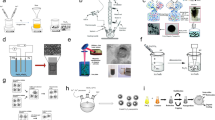Abstract
A new automated synthesis procedure of 1-H-1-(3-[18F]fluoro-2-hydroxypropyl)-2-nitroimidazole ([18F]FMISO), a specific hypoxia imaging agent with great significances for the noninvasive, dynamic hypoxia evaluation of cancer, was developed by modifying Explora FDG4 module, a commercial [18F]FDG production system, in this study. Its radiochemical synthesis was carried out via two sequent reaction steps, i.e. the nucleophilic displacement of labeling precursor 1-(2′-nitro-1′-imidazolyl)-2-O-tetrahydropyranyl-3-O-tosyl-propanediol (NITTP) with activated 18F- ion at 100 °C for 8 minutes, and the following hydrolysis with 1M HCl at 100 °C for 5 minutes and neutralization with 1M NaOH. Two-pot reaction with two independent separations was adopted to assure the good separation of final product via solid phase extraction (SPE) based upon combined Sep-pak cartridges instead of high performance liquid chromatography (HPLC). This fast, reliable preparation route of 18F-FMISO could complete within 50 minutes with about 55% of high radiochemical yield (with decay correction) and more than 98% of good radiochemical purity. The modified module could perform multiple runs of production of [18F]FMISO.
Similar content being viewed by others
References
D. Thorwarth, S. M. Eschmann, F. Holzner, et al., Radiotherapy and Oncology, 80 (2006) 151.
M. M. Graham, L. M. Peterson, J. M. Link, et al., J. Nucl. Med., 38 (1997) 1631.
S. M. Eschmann, F. Paulsen, M. Reimold, et al., J. Nucl. Med., 46 (2005) 253.
L. M. Cher, C. Murone, N. Lawrentschuk, et al., J. Nucl. Med., 47 (2006) 410.
E. L. Kämäräinen, T. Kyllönen, O. Nihtilä, et al., J. Label. Compd. Radiopharm., 47 (2004) 37.
M. Patt, M. Kuntzsch, H. J. Machulla, et al., J. Radioanal. Nucl. Chem., 240 (1999) 925.
C. W. Chang, T. K. Chou, R. S. Liu, et al., Appl. Radiat. Isotopes, 65 (2007) 682.
S. J. Oh, D. Y. Chi, C. Mosdzianowski, et al., Nucl. Med. Biol., 32 (2005) 899.
J. L. Lim, M. S. Berridge, Appl. Radiat. Isotopes, 44 (1993) 1085.
G. H. Tang, M. F. Wang, X. L. Tang, et al., Nucl. Med. Biol., 32 (2005) 553.
G. H. Tang, M. F. Wang, L. Luo, et al., J. Nucl. Radiochem., 27 (2005) 43.
J. C. Hung, J. Nucl. Med., 43 (2002) 1495.
Author information
Authors and Affiliations
Corresponding author
Rights and permissions
About this article
Cite this article
Wang, M., Zhang, Y., Zhang, Y. et al. Automated synthesis of hypoxia imaging agent [18F]FMISO based upon a modified Explora FDG4 module. J Radioanal Nucl Chem 280, 149–155 (2009). https://doi.org/10.1007/s10967-008-7395-8
Received:
Published:
Issue Date:
DOI: https://doi.org/10.1007/s10967-008-7395-8




